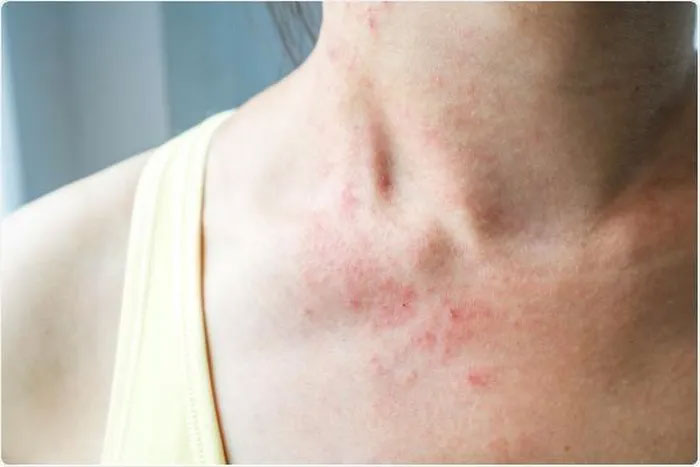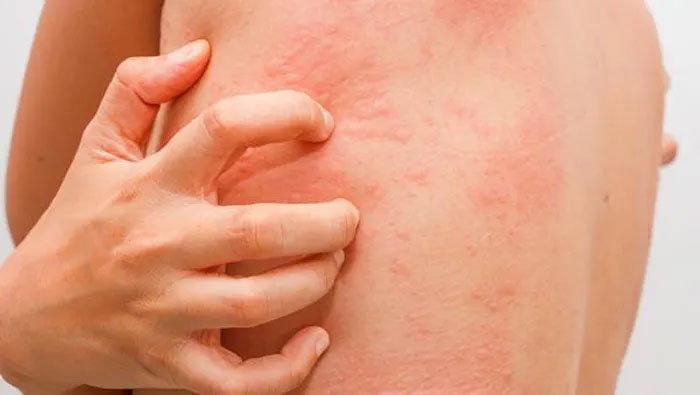A large number of Covid-19 patients who have recovered still experience post-Covid-19 issues (also known as long Covid syndrome). This not only affects their health but also impacts psychological factors, subsequently diminishing the quality of life for these patients. Common symptoms include urticaria and skin rashes…
Currently, many patients who have contracted Covid-19 are facing persistent symptoms, and some even have to return to the hospital for treatment. Research results indicate that 33% -76% of patients may experience post-Covid-19 symptoms lasting at least 6 months after infection.
The World Health Organization (WHO) has published the first official definition of Post-Covid-19 Syndrome. Accordingly, this condition occurs in individuals with a history of infection who exhibit symptoms lasting at least 2 months that cannot be explained by alternative diagnoses.
This condition can lead to prolonged health deterioration, significantly impacting the ability to return to work or participate in social life. Post-Covid-19 affects both physical and mental health and can result in significant economic consequences for individuals, families, and society.
1. Why does post-Covid-19 urticaria occur?
There are approximately 200 symptoms associated with Post-Covid-19 Syndrome, particularly among patients who have undergone intensive care treatment. Individuals infected with Covid-19 may face a range of lingering symptoms and sequelae for weeks to months after recovery, including mild fever, shortness of breath, persistent cough, fatigue, muscle and joint pain, hair loss, pulmonary fibrosis, rapid heartbeat or palpitations, gastrointestinal disorders (loss of appetite, nausea, stomach pain, diarrhea…), and disturbances in taste or smell… Among these, the majority of cases experience urticaria symptoms.

Most post-Covid-19 cases experience urticaria symptoms.
Urticaria manifests as skin lesions characterized by raised welts surrounded by red patches, which are very itchy. These welts can last from 30 minutes to 36 hours, ranging in size from 1 mm to several cm (giant urticaria), and lose color when pressed. The hallmark of urticaria is the dilation of blood vessels and increased permeability. Urticaria may or may not be accompanied by angioedema, which is primarily characterized by swelling, with the skin appearing red or normal, less itchy but painful and burning.
Urticaria is typically classified into two main groups:
- Acute urticaria when symptoms appear for less than 6 weeks
- Chronic urticaria when it persists and recurs for more than 6 weeks.
The appearance of erythematous patches on the skin surface is believed to be due to the increased sensitivity of mast cells, which release histamine and other chemical mediators such as leukotrienes, cytokines, and chemokines, leading to increased vascular permeability and swelling of the skin tissue, along with vasodilation causing redness.
Previously, it was thought that urticaria on the skin was caused by medications used to treat Covid-19. However, many cases have been reported where this condition emerged even before medication was administered. Nonetheless, many scientists believe that post-Covid-19 urticaria is a result of acute systemic inflammatory responses triggered by SARS-CoV-2, leading to the release of pro-inflammatory cytokines and activation of mast cells.
2. How to appropriately treat post-Covid-19 urticaria?
It is important to note that the urticaria discussed in this article is a common symptom during and after the Covid-19 infection phase. Therefore, treating Covid-19 remains foundational, and patients need to adhere to treatment protocols for a quicker recovery.
According to information from the American Academy of Dermatology, urticaria in Covid-19 patients may last from 2 to 12 days. On average, most individuals experience it for about 8 days. However, symptoms affecting the toes may persist for 10 to 14 days. If symptoms exceed this duration, patients may consider the following specific treatments.
2.1. Non-Pharmacological Treatment
- Discontinue all medications or foods suspected of causing allergies.
- Avoid scratching or vigorous rubbing of the skin.
- Cold compresses or cold baths may be beneficial; avoid hot baths.
- Avoid direct sunlight.
- De-worming and constipation prevention.
- Wear light, comfortable cotton clothing.
- Avoid strenuous activities or triggers that cause sweating.
- Try to rest and reduce stress.
- Avoid scratching or vigorous rubbing of the skin.

Avoid scratching or vigorous rubbing of the skin.
2.2. Pharmacological Treatment
Antihistamine Medications
Antihistamines are divided into two generations:
- First generation (diphenhydramine, chlorpheniramine, hydroxyzine)
- Second generation (cetirizine, loratadine, fexofenadine)
Second-generation medications are preferred for both adults and children due to their fewer side effects and lower required doses compared to first-generation drugs. Treatment with H1 antihistamines helps reduce swelling and itchiness.
Cetirizine acts quickly and stabilizes mast cell activity. It also has a mild sedative effect when taken at appropriate doses. This medication is available in both injectable and oral forms with the same dosage for both routes. The injectable form is suitable for adults and children aged 12 and older. For younger children, the prescribed dosage must be followed. Caution is advised when maintaining doses for patients with kidney or liver impairment.
Levocetirizine is an active isomer of cetirizine but requires a lower dose (about half). However, levocetirizine cannot replace cetirizine for patients who do not respond to it. The side effects include sedation similar to other second-generation antihistamines, and dose reductions are necessary for patients with kidney impairment.
Loratadine is a selective H1 antihistamine with a prolonged action. For patients with kidney or liver impairment, it is recommended to take it every other day.
Fexofenadine is used to treat urticaria in adults and children over 6 years old.
Common side effects include headaches, nausea, and dizziness. It is better to avoid taking the medication with meals, especially not to combine it with fruit juices.
Glucocorticoids (such as prednisolone) do not inhibit mast cell release but prevent the activity of inflammatory responses. Due to their numerous side effects, they should only be used in cases of acute, severe urticaria or certain cases of urticaria due to vasculitis that do not respond to standard antihistamines. They should not be used to treat chronic spontaneous urticaria.
3. Doctor’s Recommendations
- Do not self-medicate without the guidance of a physician.
- When a Covid-19 patient develops urticaria, it is essential to monitor for other symptoms simultaneously. If urticaria appears suddenly and spreads or occurs alongside fever, pain, blistering, or signs of infection such as swelling, heat, or pus, and respiratory distress signs like rapid breathing, shortness of breath, or decreased SpO2,
stop the medication immediately and contact a physician if experiencing severe side effects such as swelling of the face, lips, or tongue, difficulty breathing or swallowing, abnormal rapid heartbeat, or severe dizziness.


















































